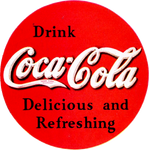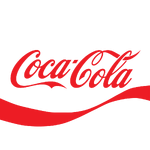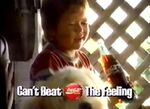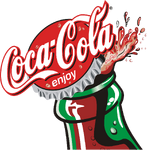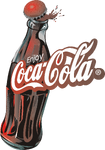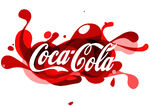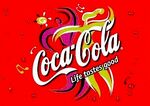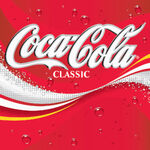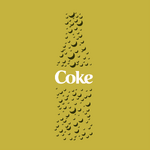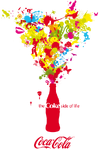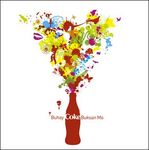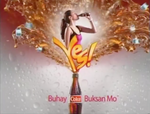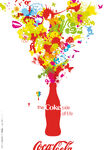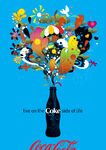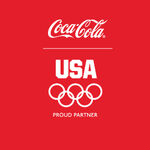1887–1941
1891–1941
1941–present
1950–2000
In 1950, the wordmark was placed in a red circle once again, but this time a portrait of a Coca-Cola bottle was seen behind the script. This version was used on a Coca-Cola commercial in 1985, and was seen most prominently in advertising from 1993 until 2000. It is still used on some vending machines, road signs, store signs and advertising signs today.
1958–1969
The script was commonly seen in an Arciform shape from 1958 to 1969. The shape was also known as the "Fishtail".
1969–1987
In 1969, the script was accompanied by the famous "Dynamic Ribbon" or "White Swirl" for the first time. The two elements were combined to create a new logo called the "Arden Square". In 1971, the "Hilltop" advert was broadcast on television, accompanied by this logo and the now-famous "It's the Real Thing" slogan for the very first time.
Starting in 1985, the script was only used on packaging in a very small size, and the below "Coke" logo took pride of place until 1987. Lippincott & Marguiles was the agency behind this design change.
1985–1987 (primary); 2019 (limited re-release)
In the United States, the formula for Coca-Cola was changed for the first time ever, in response to Pepsi gaining more sales at the time. There was a large outcry against this change in formula, and customers began boycotting The Coca-Cola Company. Coca-Cola eventually decided to return the drink to its original formula (albeit with cane sugar replaced by a cheaper alternative).
During the "New Coke" period, the logo above would be far more prominent than the traditional 1941 logo when placed on packaging for cans and bottles. This logo is still used in some countries today, albeit in modified forms.
In May 2019, to promote the third season of Stranger Things (which took place the same year the formula was introduced), the formula was brought back for a limited time.
1987–2009
1987–2000
In 1987, the company's tradtitional branding returned after the failure of New Coke. However, it now varied from country to country; the US, for example, included "Classic" in small writing underneath the script to distinguish it from the failed New Coke product. This would continue to be used until the early 2000s in conjunction with the bold 1985 Coke logo depending on the country.
In creating this brand refresh, Landor Associates created 800 different designs that combined the "Coca-Cola" or "Coke" wordmarks with the "Dynamic Ribbon". In the chosen solution, the curve was integrated with the Spencerian script by having it drawn through the second "O". An additional silver ribbon was added to the curve, and the Spencerian script was redrawn to be slightly straightened up.
Adverisements and Television Commercials
1993–2000
In 1993, it was common for the Coca-Cola script to be in a circle (and sometimes still is), and the circle itself to have a green banner above it reading "Always". The two main advertising campaigns emphasized this, their names being the "Polar Bears" and the "Christmas Trucks". During this period, most of the branding from 1986 would be used, with the circular icon normally being for corporate uses such as on vending machines and memorabilia. However, depending on the country, the bottle symbol was used more often on packaging.
1996–2000
In 1996, this version of "Always Coca-Cola" red disc began to be used on cans and bottles, with "always" appearing in English, Italian, Polish, Portuguese and French.
1996–2003
In the same year, a drop shadow was added to the 1987 logo.
1996–2003
This version of the 1987 script without the "Dynamic Ribbon" is still used on bottle caps (except for ones on aluminium bottles) in some countries.
1999–2003
In 1999, Coca-Cola launched its "enjoy" advertising campaign, with the script being placed on a bottle cap of a green-tinted Coke bottle opening. This logo was used on cans and bottles until 2003.
2003–2009
In early 2003, the "Dynamic Ribbon" was redesigned, and packaging began to differ widely around the world as a result. This branding change was made as an attempt to bring all of the different countries' Coke branding into line with one design, which included the addition of yellow to the ribbon design. This objective succeeded, although some countries still used elements of Coke's 1987 and 1990s branding. During this period, the two "Coke" logos in use were modernized, and the company launched the "Coca-Cola... Real" campaign. This logo is still used on some soda fountains.
2003–present
This version of the 1941 script without the "Dynamic Ribbon" is used on bottle caps.
2006–2009
The Coca-Cola logo inside the contour bottle silhouette was introduced with The Coke Side of Life campaign in 2006. In the Philippines, the campaign is known as "Buhay Coke, Buksan Mo".
2007–2017
A simplified design created with Turner Duckworth was introduced in early 2007. By now, the Coca-Cola logo was surrounded by various elements from three different branding eras, being that of 1969, 1987 and 2003. The Coca-Cola Company therefore believed a complete overhaul was needed, and it was decided to strip the branding back to basics, with just the script and the simplified "Dynamic Ribbon" design. This logo was introduced on cans and bottles worldwide starting in 2007. In 2009, the United States of America removed the 'Classic' wordmark from beneath the main script logo because it was no longer needed to distiguish it from the former 'New Coke'.
2007–2016
Coca-Cola red disc has a cleaner feel, introduced in advertising from late 2007 until it was simplified in January 2016.
2009–present
In January 2009, the Open Happiness campaign and slogan was launched, and the Coca-Cola logo inside the contour bottle silhouette was altered.
2016–present
In January 2016, Coca-Cola introduced a two-dimensional version of their classic "red disc" logo and their current worldwide slogan, "Taste the Feeling", under the "One Brand" strategy.




